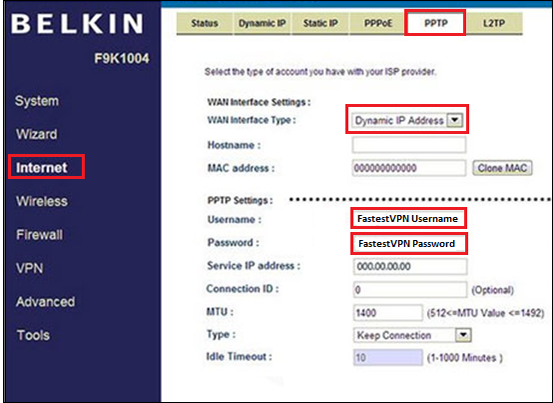


It is important to make sure that the selected User Group has been permitted access for PPTP VPN: In this case the default "admin" group is used, however, you can create a separate group specifically for VPN users if desired. Select the User Groups which will have access to PPTP VPN. In the example below 192.168.1.10-20 is entered, which is part of the default VLAN1 (192.168.1.0/24) and you can see "Subnet range error".įor this example PPTP clients are configured to use the range of 192.168.2.10-192.168.2.20 which is not in use by another VLAN. By default you cannot use subnets which are already in use by other VLANs on RV340/RV345. Select an appropriate pool of IPs for the PPTP clients. The first step is to enable the PPTP Server:
#Setup pptp connection how to
Powered by Ghost.This article will describe how to configure PPTP VPN on the new RV340/345 routers from the Small Business series.

#Setup pptp connection mac
Share: Twitter Facebook LinkedIn CommentsĪWS (44) Python (44) Docker (32) Linux (26) Elasticsearch (24) Storage (19) Kubernetes (19) DevOps (16) Security (13) Python Flask (12) Monitoring (12) MongoDB (11) BigData (11) CICD (11) DynamoDB (10) NoSQL (9) Networking (9) Databases (8) IAM (8) Swarm (8) Traefik (8) RaspberryPi (8) Golang (8) Civo (8) S3 (7) Ubuntu (7) Lambda (7) NFS (7) VPN (6) Clustering (6) Analytics (6) GlusterFS (6) Java (6) API (6) Concourse (6) Programming (6) Pipelines (6) Prometheus (6) K3S (6) Authentication (5) Kibana (5) Deployment (5) Virtualization (5) Distributed Storage (5) Scripting (5) MySQL (5) Flask-Series (5) Nginx (5) Encryption (5) Ruby (4) Logstash (4) Hadoop (4) SSH (4) Bash (4) CLI (4) Filebeat (4) Performance (4) Alpine (4) Serverless (4) OpenFaas (4) Nagios (4) ELK (3) Mail (3) High-Availability (3) Ansible (3) Nodejs (3) MicroServices (3) Cryptography (3) Gitlab (3) Gitea (3) Drone (3) Grafana (3) ECS (3) Rails (2) Active Directory (2) DNS (2) Spark (2) Hive (2) EMR (2) LoadBalancer (2) Boto (2) Payara (2) WebApps (2) Reverse-Proxy (2) Minio (2) RocketChat (2) Search-Engine (2) API-Gateway (2) Terraform (2) EC2 (2) SSM (2) Ansible-Tutorial (2) Hello-World (2) Ruby-Tutorial-Series (2) Memcached (2) Caching (2) golang-tutorial (2) Multiprocessing (2) Letsencrypt (2) Metrics (2) Jenkins (2) Longhorn (2) Multipass (2) Getting Started (1) JavaScript (1) Piranha (1) asp.net (1) apache (1) mono (1) Management (1) HDFS (1) JavaSDK (1) Commands (1) Access Control (1) Pig (1) PySpark (1) DataPipeline (1) PHP (1) LXD (1) LXC (1) Athena (1) KMS (1) LAMP (1) Wordpress (1) XtreemFS (1) S3DistCp (1) Proxy (1) Data-Durability (1) Mino (1) Object Storage (1) Docker-Stacks (1) HAProxy (1) Scraping (1) BeautifulSoup (1) Backups (1) CentOS (1) Adminstration (1) CI (1) IPsec (1) RDS (1) KVM (1) Rancher (1) k8s (1) 12Factor (1) EBS (1) Flata (1) LVM (1) Twilio (1) Secrets (1) Geo-Location (1) Mac (1) SpringBoot (1) Maven (1) RSS (1) Feedparser (1) Web-Scraping (1) Email (1) SMTP (1) Sendgrid (1) SQLite (1) Troubleshooting (1) Honeypot (1) SecretsManager (1) Dev-Setup (1) APM (1) Heroku (1) Slack (1) Logging (1) SSL (1) Containers (1) Scaleway (1) Kapsule (1) AlertManager (1) Alarming (1) PushGateway (1) Blackbox-Exporter (1) SAM (1) Inlets (1) k3sup (1) Google (1) Fluentd (1) VPC (1) Cassandra (1) k3d (1) Cloud-Init (1) CloudWatch (1) S3-Events (1) REDO (1) Git (1) Permissions (1) PiVPN (1) Github-Actions (1) Loki (1) Cost-Savings (1) CodeBuild (1) Bitwarden (1) Self-Hosted (1) Populate the following value: _forward=1Įnable the service on boot and start the service: $ systemctl enable pptpd
#Setup pptp connection install
Update Repositories and install PPTPD: $ apt update & apt upgrade -yĬonfigure your Authentication $ vi /etc/ppp/chap-secretsĬonfigure Local and Remote IP, in this case I want 10.1.1.2 to 10.1.5.1-254 $ vi /etc/nf

Make the following changes: GRUB_CMDLINE_LINUX_DEFAULT="ipv6.disable=1" In this post we will setup a PPTP VPN on Ubuntu 16.04 Disable IPv6 Networking:Įdit the grub config: $ vi /etc/default/grub


 0 kommentar(er)
0 kommentar(er)
